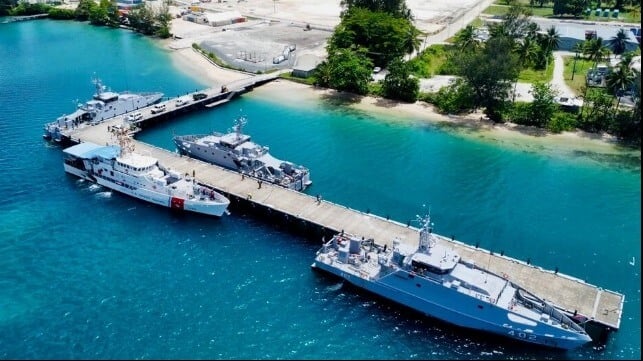Mutual Benefits from US Military Deal with Papua New Guinea

[By: Michael A. Allen, Carla Martinez Machain, and Michael E. Flynn]
The United States announced a new military agreement with Papua New Guinea, the most populous Pacific island country, on May 22, 2023.
The deal came shortly after U.S. President Joe Biden announced plans to visit the small island country – the first U.S. president ever to do so. However, continuing fraught budget negotiations in the U.S. led Biden to cancel his plans on May 17.
The details of the military agreement will be made public over the next few months – but U.S. and Papua New Guinea government officials have said that the deal is focused on supporting Papua New Guinea’s defense forces and increasing regional stability.
China is not mentioned explicitly in the announcement of the deal, but we would be remiss in failing to note the connection.
We are experts in U.S. security cooperation and recently published a book about U.S. overseas military deployments. In it, we discuss how U.S. commitments to weaker countries benefit the U.S. and how the broader geopolitical competition with China matters to U.S. military cooperation.
Papua New Guinea’s relevance
Papua New Guinea is located on the eastern half of the island of New Guinea, about 90 miles north of Australia. It has a population of 10 million people and a military with approximately 3,000 active-duty personnel.
The United States’ proposed 2023 military spending budget is over 8,400 times the island country’s annual military spending.
Papua New Guinea has a long history of colonization. The British government took over control of the southeast part of the overall island of New Guinea in the late 1800s, while Germany annexed the northern part.
Australia then took over control of Papua New Guinea in the early 1900s. Papua New Guinea gained independence in 1975. The western half of the island is called Papua and is part of Indonesia.
Papua New Guinea has also served as a strategic location for the U.S. in the past.
During World War II, for example, Papua New Guinea was the site of a long and bloody campaign fought by the Americans and Australians against the Japanese military, who had occupied parts of the island.
Some Papuans have expressed concern about their independence following the U.S. military deal’s announcement. Papuan university students have been protesting the agreement, asking for more clarity on the pact’s details.
Today, Papua New Guinea remains strategically located. Anyone with military access to Papua New Guinea could easily reach Australia, a key U.S. ally, by air or sea, with no need for refueling.
And the United States’ military support and training to Papua New Guinea itself could be a further way for the U.S. military to gain influence on the island and shift military policy to fall more in line with that of the U.S.
Who benefits from the deal
What the U.S. gains from supporting a smaller country with a small military may not seem immediately obvious.
But while Papua New Guinea is a small country, it is important from a geographical and diplomatic position, given its proximity to Indonesia, Australia and the Solomon Islands.
Indeed, the U.S. has security agreements and and partnerships with dozens of countries – such as Colombia and Kenya – that have weaker militaries and less money than the U.S.
We have long studied this question of who benefits when the U.S. partners with a smaller country and found that both countries benefit.
When the U.S. gives military aid to another country, regardless of its wealth, that place generally tends to spend less on its own defense. The one exception to that is when the U.S. gives money to support militaries in countries that are part of the North Atlantic Treaty Organization – in that case, countries may respond to U.S. help with spending more on their militaries, too, because of shared interests.
But there are also some strings attached.
Some scholars have argued that a smaller military power like Papua New Guinea gives up sovereignty or autonomy over its foreign policy in exchange for U.S. support.
In that case, the U.S. is exchanging money for Papua New Guinea to align its decisions with the U.S., instead of China. The U.S. gets a commitment from Papua New Guinea to make decisions that are more favorable to U.S. interests and less favorable to China.
US-China competition
The U.S. and China are clearly engaged in competition with each other over military, political and economic might.
The U.S. is arguably the dominant global power, but China’s strength and influence continue to rise across Asia and Africa, as it has been making military agreements with such countries as the Solomon Islands, Djibouti and Thailand.
There have been several incidents that recently escalated tensions between the U.S. and China.
One of these tension-raising events focused on the U.S. Air Force’s shooting down a Chinese balloon – allegedly used for spying – that flew across the U.S. in early 2023.
What’s next in the Pacific
Our work shows that a lack of transparency leads to more suspicion against U.S. military deployments abroad.
While the U.S.-Papua New Guinea deal may come with security benefits for both countries, continuing university protests on the island highlight that not everyone in the country wants U.S. involvement – or the risk of giving up the country’s ability to make decisions, independent of any outside military pressure.
Based on our research, we think that increased transparency on the deal may assuage some of these concerns and make it more likely to be successful.
About the Authors:
Michael A. Allen
Professor of Political Science, Boise State University
Carla Martinez Machain
Professor of Political Science, University at Buffalo
Michael E. Flynn
Professor of Political Science, Kansas State University
This article is republished from The Conversation under a Creative Commons license. Read the original article.
The opinions expressed herein are the author's and not necessarily those of The Maritime Executive.
